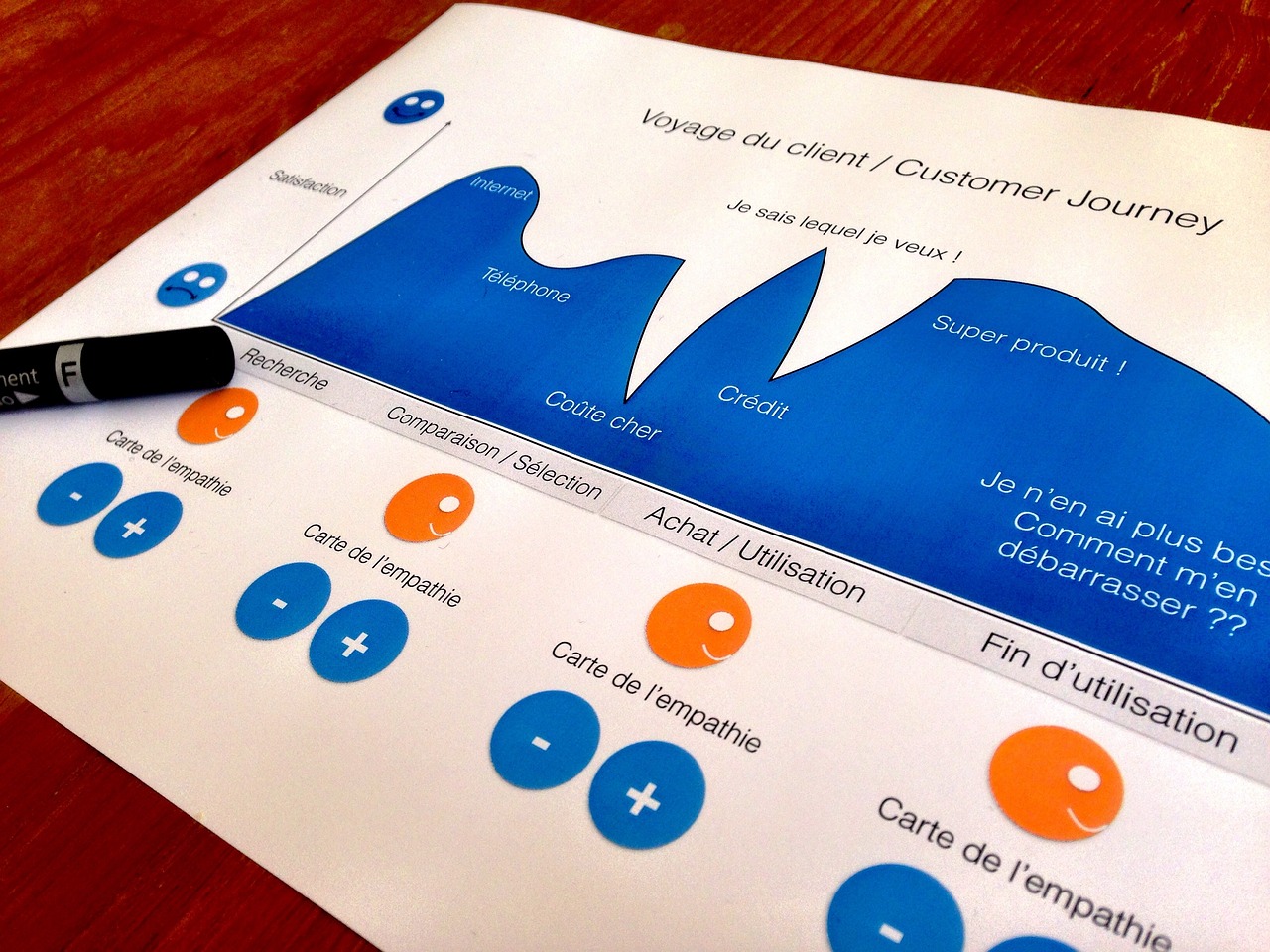Looking to enhance your digital marketing skills and take your online presence to the next level? Look no further than Customer Journey Mapping for Digital Marketers. This article dives into the world of customer journey mapping, providing valuable insights and strategies to help you understand and optimize the path your customers take from discovery to conversion. With the ever-changing digital landscape, staying ahead is crucial, and this article is here to equip you with the latest best practices and techniques to drive results and stand out in the online market. So, whether you’re a seasoned digital marketer or a beginner looking to make your mark, Customer Journey Mapping for Digital Marketers is your go-to resource for navigating the world of online marketing effectively.

1. What is Customer Journey Mapping?
Customer journey mapping is a process that digital marketers use to understand and visualize the entire experience that a customer has with their brand. It involves mapping out each touchpoint and interaction that a customer has with the brand, from the initial awareness stage to the final purchase or conversion. By creating a customer journey map, marketers can gain valuable insights into the customer’s perspective, needs, and motivations throughout their buying journey.
2. Why is Customer Journey Mapping Important for Digital Marketers?
Customer journey mapping is crucial for digital marketers because it enables them to better understand their customers and their behavior. By mapping out the entire customer journey, marketers can identify pain points, gaps in the customer experience, and areas for improvement. This understanding allows them to create more targeted and effective marketing campaigns, tailored to the specific needs and desires of their customers. Customer journey mapping also helps marketers align their strategies with the customer’s journey, ultimately leading to increased customer satisfaction and loyalty.

3. Steps to Create a Customer Journey Map
3.1 Define Your Customer Persona
The first step in creating a customer journey map is to define your customer persona. This involves creating a detailed profile of your ideal customer, including their demographics, interests, motivations, and pain points. By understanding who your customer is, you can better anticipate their needs and tailor your marketing efforts accordingly.
3.2 Identify Customer Touchpoints
Once you have defined your customer persona, the next step is to identify all the touchpoints where customers interact with your brand. This includes both digital and non-digital touchpoints, such as visiting your website, browsing social media, reading reviews, contacting customer support, or visiting a physical store. Mapping out these touchpoints allows you to see the various channels through which customers interact with your brand.
3.3 Determine Customer Goals and Motivations
Understanding your customer’s goals and motivations is crucial in creating an effective customer journey map. By putting yourself in the customer’s shoes and identifying what they are trying to achieve at each touchpoint, you can better align your marketing efforts with their needs. This step requires research and data analysis to gain insights into customer behavior and preferences.
3.4 Map the Customer Journey
Now that you have identified your customer touchpoints and their goals, it’s time to map out the customer journey. Start with the customer’s initial awareness of your brand and follow their journey through each touchpoint until the final conversion. Use visual elements such as timelines, flowcharts, or diagrams to create a clear and comprehensive representation of the customer journey. This map will serve as a reference point for analyzing and optimizing the customer’s experience.
3.5 Analyze and Identify Pain Points
Once the customer journey map is created, it’s essential to analyze it and identify any pain points or areas of friction in the customer’s experience. This could include long wait times, confusing navigation, lack of personalization, or any other issues that may hinder the customer’s journey. Through this analysis, you can gain insights into the customer’s perspective and make informed decisions on how to improve their experience.
3.6 Identify Opportunities for Improvement
The final step in creating a customer journey map is to identify opportunities for improvement. Based on the pain points and gaps identified in the previous step, brainstorm and prioritize strategies to enhance the customer experience at each touchpoint. This could involve optimizing website usability, streamlining the checkout process, providing personalized recommendations, or improving customer support services. By continuously seeking opportunities to improve, you can enhance the overall customer journey and drive better results for your digital marketing efforts.
4. Tools and Software for Customer Journey Mapping
There are various tools and software available to aid in the process of customer journey mapping. These tools provide templates, visualizations, and collaboration features to make the mapping process more efficient and effective. Some popular tools include:
-
UXPressia: This tool offers pre-designed templates and drag-and-drop functionality for creating customer journey maps. It also allows for collaboration and sharing of maps with team members.
-
Smaply: Smaply provides interactive journey map visualizations and offers features to analyze and share customer journey insights. It also includes persona creation and stakeholder mapping functionalities.
-
Lucidchart: Lucidchart is a versatile diagramming tool that can be used for customer journey mapping. It provides a wide range of templates and customization options to create detailed and visually appealing journey maps.
-
Miro: Miro is a collaborative online whiteboard platform that can be used for customer journey mapping. It allows multiple team members to work together in real-time, making it ideal for remote and distributed teams.
-
Adobe XD: Adobe XD is a design tool that can be used for creating interactive prototypes and wireframes of customer journeys. It offers a range of features specifically designed for user experience design and prototyping.
These tools can significantly streamline the process of customer journey mapping and provide a visual representation of the customer’s experience.

5. Examples of Effective Customer Journey Maps
To better understand how customer journey maps can be implemented, let’s take a look at some examples of effective maps:
Example 1: E-commerce Customer Journey Map In this example, the customer journey map starts with the customer discovering the brand through social media or search engine results. It then follows their journey through various touchpoints, such as visiting the website, browsing products, adding items to the cart, and making a purchase. The map also includes potential post-purchase touchpoints, such as receiving an email confirmation and leaving a review. This map helps the digital marketer identify potential pain points and areas for improvement, such as optimizing the website for mobile devices or simplifying the checkout process.
Example 2: Subscription Service Customer Journey Map For a subscription service, the customer journey map could start with the customer’s initial awareness of the service through online advertisements or word-of-mouth recommendations. It then depicts the customer signing up for a free trial, accessing the platform, and exploring the available features. The map also includes touchpoints related to billing, customer support, and feedback collection. By analyzing this map, digital marketers can identify opportunities to improve the onboarding process, streamline billing procedures, and enhance customer support services.
These examples demonstrate how customer journey maps can be customized to different industries and business models, highlighting the unique touchpoints and interactions specific to each customer’s journey.
6. Benefits of Customer Journey Mapping for Digital Marketers
Customer journey mapping offers several benefits for digital marketers. Here are a few:
1. Improved Customer Understanding: By mapping out the customer journey, marketers can gain a deeper understanding of their customers, their needs, and their motivations. This knowledge allows for more targeted and relevant marketing strategies.
2. Enhanced Customer Experience: Customer journey mapping helps identify pain points and areas of improvement in the customer experience. By addressing these issues, marketers can enhance the overall customer experience and build stronger relationships with their customers.
3. Increased Conversion Rates: By understanding the customer journey and optimizing each touchpoint, marketers can increase conversion rates. By meeting the customer’s needs at each stage, they can guide them towards making a purchase or conversion.
4. Improved Marketing ROI: With a clearer understanding of the customer journey, marketers can allocate their resources more effectively. By focusing on the touchpoints that have the most significant impact on the customer’s decision-making process, they can optimize their marketing efforts and improve return on investment.
5. Better Alignment with Customer Expectations: Customer journey mapping helps marketers better align their strategies with customer expectations. By understanding the customer’s perspective, motivations, and goals, marketers can create more relevant and personalized marketing campaigns.
Overall, customer journey mapping is a valuable tool for digital marketers to understand their customers better, enhance the customer experience, and increase the effectiveness of their marketing efforts.
7. Challenges and Limitations of Customer Journey Mapping
While customer journey mapping can provide profound insights, it also comes with its challenges and limitations that digital marketers should be aware of:
1. Complex and Evolving Customer Journeys: Customer journeys can be complex and can vary significantly across different customers, making it challenging to create a universally applicable customer journey map. Additionally, customer journeys evolve as customer preferences change and new technologies emerge, requiring constant monitoring and updates to stay relevant.
2. Lack of Data and Insight: Creating an accurate customer journey map relies on having access to reliable data and insights about customer behavior. Obtaining this data can be challenging, especially for smaller businesses with limited resources. Additionally, customers may not always provide accurate information about their experiences, making it difficult to create an accurate map.
3. Overwhelming Amount of Touchpoints: Depending on the industry and business model, there can be a vast number of touchpoints for customers to interact with. Mapping out each touchpoint can be overwhelming and time-consuming, requiring a significant investment of resources.
4. Difficulty in Prioritizing Improvements: Identifying pain points and areas for improvement is only the first step. Deciding which improvements to prioritize and implementing them effectively can be challenging. Marketers need to consider various factors such as budget, resources, and feasibility when deciding on improvement strategies.
Despite these challenges and limitations, customer journey mapping remains a valuable tool for digital marketers to gain insights into their customers’ experiences and improve their marketing strategies.
8. Integrating Customer Journey Mapping into Digital Marketing Strategies
To effectively integrate customer journey mapping into digital marketing strategies, consider the following steps:
1. Align Marketing Efforts with the Customer Journey: Use the customer journey map to guide the development of marketing strategies. Ensure that each touchpoint is optimized to meet the customer’s needs and expectations.
2. Personalize Marketing Campaigns: Leverage the insights gained from customer journey mapping to create personalized marketing campaigns. Tailor your messages and content to align with each touchpoint and the customer’s goals and motivations.
3. Continuously Monitor and Update the Customer Journey Map: Customer journeys evolve over time, so it’s essential to continuously monitor and update the customer journey map. Regularly collect feedback and data from customers to ensure that the map remains accurate and relevant.
4. Experiment and Measure Results: Use customer journey mapping as a guide to experiment with different marketing strategies and track the results. Continuously analyze the data to identify areas for improvement and optimize your marketing efforts.
By integrating customer journey mapping into your digital marketing strategies, you can create more targeted, personalized, and effective campaigns that align with the customer’s journey.
9. Tips for Successful Customer Journey Mapping
To make the most of customer journey mapping, consider the following tips:
1. Involve a Diverse Team: Include team members from different departments, such as marketing, sales, customer support, and product development. This diversity will provide different perspectives and insights that can contribute to a comprehensive customer journey map.
2. Collect a Wide Range of Data: Gather data from various sources, such as surveys, customer feedback, website analytics, and social media insights. A diverse range of data will help create a more accurate and insightful customer journey map.
3. Use Visuals to Enhance Understanding: Visual elements such as diagrams, timelines, and flowcharts can make the customer journey map more visually appealing and easier to understand. This enhances collaboration and communication within the team.
4. Continuously Iterate and Improve: Customer journey mapping is an iterative process. Regularly review and update the map to incorporate new insights and changes in the customer journey. This will ensure that the map remains accurate and effective.
5. Seek Customer Feedback: Actively seek feedback from customers to validate and improve the customer journey map. Their input can provide valuable insights and help identify any gaps or inaccuracies in the map.
By following these tips, you can create a successful customer journey map that accurately reflects the customer’s experience and provides insights for optimizing your digital marketing strategies.
11. Conclusion
Customer journey mapping is a powerful tool for digital marketers to understand their customers better and optimize their marketing strategies. By mapping out the entire customer journey, marketers can identify pain points, gaps in the customer experience, and opportunities for improvement. This understanding allows for more targeted and personalized marketing campaigns that align with the customer’s needs and motivations. Although there are challenges and limitations to customer journey mapping, the benefits outweigh them, leading to improved customer satisfaction, increased conversion rates, and better marketing ROI. By integrating customer journey mapping into their digital marketing strategies and following the tips provided, marketers can unlock the full potential of this tool and drive better results for their brands.



